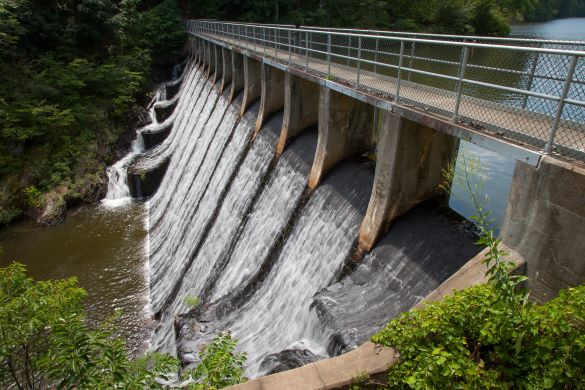
 Department of Conservation and Recreation
Department of Conservation and Recreation
Conserve. Protect. Enjoy.
 Department of Conservation and Recreation
Department of Conservation and Recreation
By Matt SabasPosted May 22, 2024
Dams are impressive feats of engineering, providing water supply, hydropower, flood reduction and recreational opportunities to surrounding communities. When dams fail, however, flooding can be catastrophic and lead to substantial economic damage, environmental impacts and/or loss of life.

May 31 is Dam Safety Awareness Day in Virginia. Dam Safety Day commemorates the 1889 failure of the South Fork Dam in Johnstown, Pennsylvania, which killed over 2,200 people and remains the worst dam-related disaster in U.S. history. This year’s theme is "Dam Safety is a shared responsibility. Know your risk, know your role, know the benefits of dams and take action."
Here are five signs that a dam might not be maintained and could be at risk of failure:
Overgrown vegetation and trees on dams. Not only can excessive vegetation around a dam interfere with safety monitoring, it can also impede drainage and destabilize the structure. Trees, in particular, are a serious safety hazard. Trees should never be allowed to grow on or near the embankment fill, at the outlet, plunge pool or spillway area.
Erosion. The biggest enemy of any dam is erosion. Surface, or external, erosion is generally obvious and can create ruts or rills on the surface of a fill and weaken the dam. This can result in an emergency situation or lead to a catastrophic failure.
Sediment accumulation. Look out for sediment, including gravel or sand, clogging the spillway or outlet pipes, or accumulating within the reservoir. If the spillway is blocked, it can lead to overtopping and potential failure of a dam.
Visible cracks and damage. Cracks or other visible damage on the surface of the dam can indicate issues with a dam’s integrity and should be reported immediately, especially after a period of heavy rainfall or larger earthquake.
Leakage. The presence of water seeping through the dams could indicate internal erosion, drainage issues or other problems with the structure. If you observe leakage, seepage or bright green patches of grass on the dam relative to other areas, contact the dam owners and DCR dam safety staff.
DCR regulates more than 2,500 dams in Virginia. To find out if you’re in a dam inundation zone and determine your flood risk, visit Virginia Flood Risk Information System (VFRIS). You can learn more about dams in your area by viewing our Open Data Hub or exploring the Army Corps of Engineers’ National Inventory of Dams.
Concerns about a dam? Contact DCR's Dam Safety Program staff at (804) 371-6095 or email dam@dcr.virginia.gov.
Categories
Dam Safety | Dam Safety and Floodplains
Tags
dams | flood control

